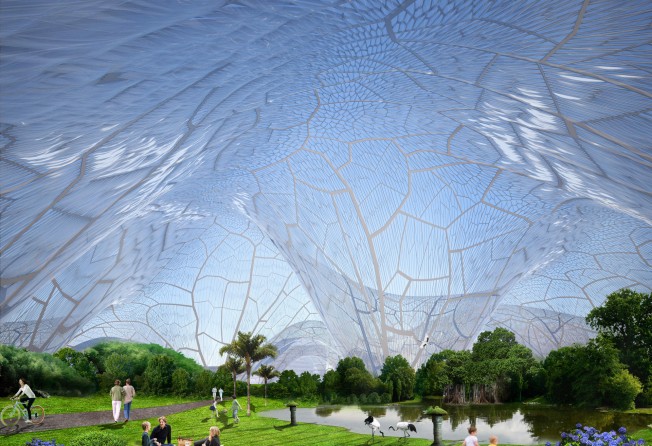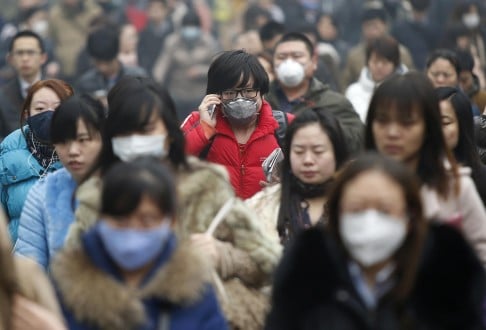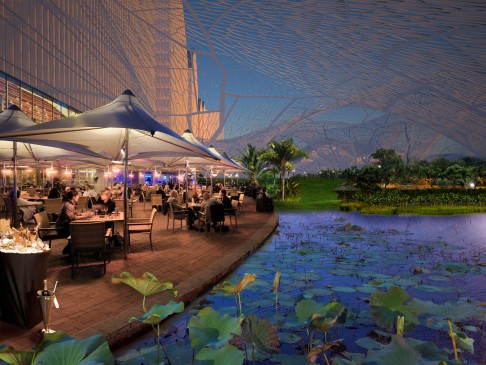Giant bubbles could be 'built over Beijing parks to save residents from smog danger'
Enclosing spaces in giant transparent domes may be a way to escape the city's dirty air

Beijing has the worst smog levels among the world's capital cities - so bad that playing sports outdoor is often banned - but it could get a stunning new set of lungs in the form of a covered botanical garden, retail and office complex under a giant transparent roof.
Called Bubbles, the architectural concept might seem an unlikely candidate for a high-rise city of 21 million people. But its designers believe it offers something that every urban environment needs.
"It's just an infrastructure project like building metro stations and parks - it's applicable in every dense, polluted metropolis where there's a need for open, green spaces throughout the year," says Rajat Sodhi at Orproject, an architecture practice with offices in London, Beijing and New Delhi.
Sodhi and his colleagues know all about air pollution. He comes from New Delhi, another capital struggling with grim air quality, while another designer is a native of the Chinese capital.
Last year Beijing suffered 60 days of pollution above the emergency levels as defined by the World Health Organisation, and barely any days with good air. "Everyone's always wearing masks [outdoors]," says Sodhi. "We're not meant to live like this."
Watch: A view of Beijing's smog from atop the Forbidden City
Orproject's answer is Bubbles. The structure encloses a botanical garden while the air is filtered, and controlled for both temperature and humidity throughout the year. Adjoining buildings could be apartments, offices and shops, though schools, sports and medical facilities would be the obvious first fit for Bubbles. It doesn't even have to include gardens; it could be used to enclose playgrounds or school yards, or the atrium or gardens of an office building, shopping mall or apartment complex.
Bubbles is based on the principles of biomimetic architecture, typically lightweight environmental structures inspired by nature. The geometry of the Bubbles canopy was generated using an algorithm that simulates the development of veins in leaves or in butterfly wings.
"In nature, there are all kinds of systems designed for a particular performance," Sodhi says. "For instance, the veins in leaves are designed not only to deliver nutrients and create a circulatory logic in the plant, but it also creates structure."

Looks expensive? The architects reckon that Bubbles would cost about HK$5,150 per square metre, or HK$7,750 per square metre if it included solar panels. That would rule out the concept for many cities in the developing world, especially in India and Africa. China, however, is an exception.
Glazing the facade of a building usually costs around HK$4,500 per square metre on the mainland, so Bubbles would be affordable, Sodhi says. China's dominant position in global manufacturing, particularly in the production of ETFE plastic panels required for the canopy, would give it an edge.
It also wouldn't be the first time that such a construction has been attempted on the mainland. "This technology was in the WaterCube building for the 2008 Beijing Olympics," says Sodhi, referring to the National Aquatics Centre.
However, Orproject's inspirations come from further away, both in distance and time.
The architects at Orproject cite engineer Richard Buckminster Fuller's radical plan for New York City in 1960 as the project's central influence. Buckminster Fuller's idea was to construct a single geodesic sphere spanning two miles of central Manhattan.
From the East River to the Hudson River, it was envisaged as a way of protecting New Yorkers from air pollution, but it could also be climate controlled to lessen the harshness of the city's bitter winters. Buckminster Fuller also proposed domes that could move around the Earth as well as floating "seastead" cities, including one for Tokyo Bay.

"Bubbles evokes design inspiration from the biomes of Cornwall's Eden Project and Singapore's Gardens by the Bay," says Sean Quinn, head of sustainable design at architecture firm 10 Design in Hong Kong, which also has offices in Dubai, Shanghai and Edinburgh.
Both biomes help create awareness of global climate and the positive effect that humans can place on it, though he admits that they also generate environmental footprints equivalent to a similarly sized office building. "Bubbles goes a step further… providing fresh air in intensely polluted regions," Quinn says.
However, he has reservations about the Bubbles attempt to replicate nature.
"There are no breezes, direct sunlight, rain, snow, changes in temperature, animals, or migratory birds," he says. "Going outside is no longer truly outdoors."
Other architects agree. "It had negative implications for the future of New York, and anyone unlucky to be stuck outside the dome," says Jason Carlow, an assistant professor in the architecture department at the University of Hong Kong, of Buckminster Fuller's plans.
Even the concept of a dome has negative connotations in pop culture. "Writers and filmmakers have long used the same architectural device to create fictional enclaves for troubled societies," Carlow says, citing the domed environments of controlled, dystopic societies in films such as Logan's Run, The Truman Show and last year's Elysium. The Hunger Games is another; the enclosed dome seems to have become almost a sci-fi shorthand for tyranny.
"Bubbles is about surviving climate change," he says. "The media has latched onto Bubbles as a solution to a problem only Beijing has, but it's a concept that could be used anywhere in the world.
"Air quality will take at least 20 years to undo - if it's even possible - and that's if the Chinese and Indian governments changed their policies right now. You have to accept that the climate is changing and we have to do something about it… in a couple of decades we may have passed beyond the mark where we can reverse anything."
Regulating temperatures are what geodesic domes are designed to do, and in unpredictable or harsh climates they could bring normality and a healthy atmosphere to all kinds of places, Sodhi adds.
"Bubbles could work in Beijing and Shanghai, and in all the major cities of China, and it could work in India in places like Delhi and Mumbai. It could also work well in cities like Moscow, where the temperature change across winter and summer is minus 20 to plus 20 degrees Celsius, and where green spaces aren't visible."
The cleaner, greener cities of Western European appear less in need of anti-pollution solutions, but the recent driving restriction in Paris is a warning against complacency.
Sceptics, however, take issue with the implications that projects such as Bubbles have on other fundamental goals.
"While Orproject's lushly rendered proposal is no doubt a well-intentioned answer to the air quality problems of cities like Beijing, it's hardly a solution," says Carlow.
"Even if sealing off large, climate-controlled spaces of the city was structurally, mechanically and economically feasible, the scenario leaves many city dwellers outside of the Bubble."
Although living, shopping or dining in the interior urban space of Orproject's Bubbles may seem like a breath of fresh air, says Carlow, "Beijing would do better to consider innovative, long-term design and regulatory solutions that address the problems of air pollution at the source, not the end user".
At its most basic, Bubbles is driven by the simplest of desires - the desire to breathe more easily - but it does fall into the category of out-of-the-box thinking in architecture.
"It's time to colonise the outside instead of just creating indoor spaces. Bubbles is scaling-up architecture, both in terms of technology and in our relationship with the built environment," Sodhi says.
Orproject has yet to receive a commission for Bubbles, but Sodhi is confident it will come. "Biomes could be very common in future," he says.
"I see them happening all over the world, if not now then certainly in the next 10 years."
Wouldn't that time be better spent reducing the emissions that create the need for enclosures like Bubble in the first place, and introducing more green space and trees to process the carbon dioxide?
"The condition and quality of our environment needs to be addressed directly and naturally, with master plan urban spaces that allow cross breezes to flush out polluted air," Quinn says.
Both are ideas that the world may quickly need to warm to.
